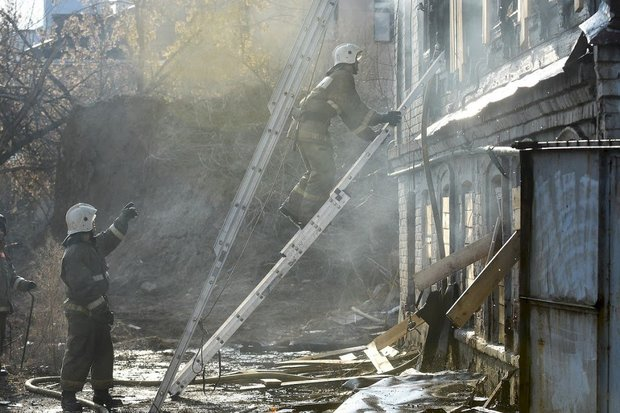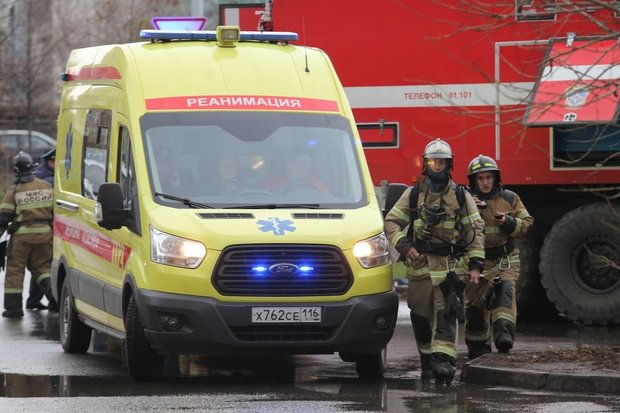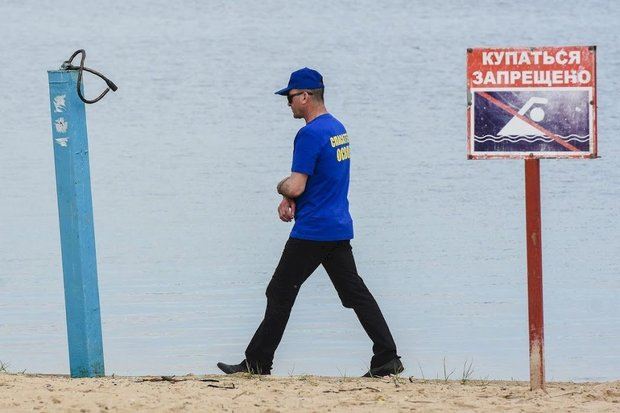How self-isolation changes statistics on tragic events in Tatarstan
The number of deaths in fires and water bodies suddenly increased last year, but alcohol became the main killer

As if it was little for Tatarstan to lose a considerable part of the population because of the terrible virus during the tough pandemic year, the region set a sad anti-record in statistics on accidents. More people died in fires and water bodies in 2020 than in 2019. The number of these victims exceeded the indicators of the last five years. In any case, the Tatarstan Ministry of Emergency Situations says the trend is negative because of the COVID-19 epidemic that made residents of the republic spend more time at home. However, Realnoe Vremya’s analytic service found out that the number of fire deaths began to rise as early as 2019, and alcohol often was and remains the cause of the tragedies.
More deaths due to fire
Tatarstan President Rustam Minnikhanov didn’t ignore the problem and asked to find out the causes of the upsurge in the amount of fire-related deaths. At a meeting of the Tatarstan office of the Russian Ministry of Emergency Situations, it was reported that Tatarstan residents stood home in 2020 like never before as a consequence of coronavirus restrictions, the number of deaths in fire increased by 9%.
Head of the Tatarstan office of the Russian Ministry of Emergency Situations Rafis Khabibullin claimed another problem — consumption of alcoholic drinks — added to one of the main causes of the mortality rate that is self-isolation. So though the amount of fires in the republic reduced from 6,065 to 5,995 (by 1%), the number of deaths, in contrast, increased from 149 to 163 people. 65% of them died in a state of alcoholic intoxication.
The installation of fire alarms didn’t help either because people often don’t have the time to wake up and go out. At the same time, the number of people who died in the water increased too (from 80 to 92, of whom 10 are children). The “hot summer” was declared as the main “perpetrator”, however, the Tatarstan president indicated the sad fact of a lack of rescue points: 56 of 150 leisure sites of Tatarstan are equipped with them. The other places have to be moved to the category “beach”, Rustam Minnikhanov stated.
We should note, as Realnoe Vremya’s analytic staff found out just two years ago, people often died in Russia (including Tatarstan) in car accidents than in buildings on fire or even air catastrophes.
The Ministry of Emergency says fires increased by 40% because of changes in the calculation method
Nevertheless, as data shows, with a general reduction in the number of emergencies and accidents (by 7,2%), the amount of deaths decreased only by 3,6%. Mainly deaths in fire and in the water spoil the statistics.
At the same time, if we consider a longer period, for instance, from 2011 to 2020, the numbers won’t be glittering. The number of emergencies (including fires, drowning and car accidents) rose by 22,6%, from 8,555 to 10,495. The number of emergencies began to go down only 2020, probably because of lower road traffic. In 2018-2019, Tatarstan had over 11,000 emergencies.
The most surprising rise was in 2018 (when Kemerovo’s Winter Cherry shopping mall suffered from a tragedy) when the number of emergencies in Tatarstan increased by 43,2% at once, from 7,735 to 11,073. The jump wasn’t caused by fires, drowning or car accidents but “other” accidents that tripled in 2018 (890 against 242).
However, the Tatarstan office of the Russian Ministry of Emergency Situations explained to Realnoe Vremya that the number of accidents skyrocketed because the method of calculation of emergencies changed: so since 2018, grass or waste burning has also had to be added to the statistics. Indeed, nearly a twofold rise in fires in Tatarstan was in 2018: 6,011 against 3,204 (moreover, the number of deaths decreased from 141 to 140).
2012 was the last bad year when the number of accidents in Tatarstan in general increased by 15,3% and the amount of victims grew almost 1,5 times. But the quantity of deaths reduced by 8,6%, while it increased by 4% in 2018 (from 675 to 703).

How epidemic spoils statistics with fire and water
Human life is anyway the main factor we are interested in in the dry statistics. And we should note that despite the mathematical growth of the number of emergencies and accidents caused by the changes in the calculation method, the number of deaths in them almost halved in the last 10 years: from 1,097 to 581, while the quantity of victims reduced 2,5 times: from 3,584 to 1,486. We will note separately that 2019 was anyway worse from a perspective of numbers than 2020, which had coronavirus, despite a formal fall in accidents. On the one hand, the number of accidents rose by 2,2% in 2019 (from 11,073 to 11,313), on the other hand, the number of deaths in them decreased by 14,2%, by 100 people at once (from 703 to 603).
The contrary happened in 2020: the number of accidents impressively decreased by 7,2% (from 11,313 accidents to 10,495), but the amount of deaths reduced approximately by 20 people. In fact, two categories of accidents did spoil the statistics — fires and situations in the water. The Traffic Police can proudly claim that the number of traffic accidents plunged by 13% in 2020 (from nearly 4,000 to 3,405) with a simultaneous fall in the number of victims (by more than 600 people), the quantity of deaths decreased by 12% (287 people died in traffic accidents in 2020 versus 326 people in 2019).
However, we shouldn’t forget that the regime of strict mobility restrictions that caused a rise in alcoholism and fires had, in contrast, a positive impact on traffic accidents: the lower road traffic, the fewer cars and buses, the fewer traffic accidents and fatalities.
Nevertheless, we can’t help but note the fact that the number of traffic accidents decreased 1,4 times from 2011 to 2020 — from 4,761 to 3,405 accidents. And the amount of deaths dropped almost twice (from 537 to 287) as a consequence of a 1,5-fold fall in the number of traffic accident victims on Tatarstan roads.
Number of deaths in fires in Tatarstan rose in 2019 too
As for fires and the number of people who died from them can’t be attributed to the coronavirus restrictions only. The case is that the number of people who died in a fire in Tatarstan grew for the second year in a row, while, as it is known, the republic didn’t have any pandemic in 2019.
However, if the number of deaths in accidents in 2019 increased by 14%, the amount of people who died in a fire rose by 6,4% — to almost 150 people. More people died in 2020 — by 8,7% — that’s to say, they total 162 people. And this happens despite the ongoing reduction of the number of victims of fire for the second year in a row (from 268 to 220 people).
On the one hand, we can say that the quantity of fires has doubled in the last 10 years only as a consequence of adding grass or waste burning to this category. On the other hand, the number of victims didn’t change from 2011 to 2020 but increased by 25% — from 176 people to 2020. The number of rescued people reduced sixfold in the last decade — in 2011, workers of the Ministry of Emergency Situations rescued over 3,000 Tatarstan residents, last year, they did only 514.

Number of deaths in fire turns out to be record-high in five years
The fact that the number of deaths in a fire in Tatarstan last year — a record in the last five years — became a sad summary. More people died only in 2013-2015 (nearly 200 people annually). Though the number of people dying in fire didn’t reduce significantly from 2016 to 2020, it hardly surpassed 140 people before 2020. Last year turned out to be the toughest. Moreover, Tatarstan didn’t see such growth in the last ten years.
The situation with accidents in the water, that’s to say, drowning, is a bit different. 92 people in total died last year, 64 people were rescued. Such a rise in fatalities the coronavirus year showed — 15% — wasn’t registered since 2015 (the number of people who died in the water rose by 23,6% at once). It isn’t enough that 2020 turned out to be the year when the number of deaths rose in general in the last five years, however, this quantity, fortunately, gradually decreased.
The statistics for 2017 and 2019 when 31% and 17,5% fewer people died than previously were positive for the Ministry of Emergency Situations. In general, despite the rousing statistics of the decade (the number of accidents in water bodies of Tatarstan decreased by 17%, from 140 to 116), the digit of accidents either grows or falls year after year.
So we will note that the number of search and rescue operations in the water grew year after year from 2011 to 2015 and reached a record high in 2015. It decreased to 127 during the next two years and rose to 133 in 2018. On the one hand, the main plus during those years was that the number of fatalities decreased incomparably with the numbers ten and five years ago when this quantity was above 130 and even 140 people. Rescuers of the Ministry of Emergency Situations managed to reduce the number of deaths, and it didn’t exceed 100 people for the fourth year in a row (2019 was a record year when 80 people in total died).

Alcohol, not hot weather, is one of the main causes of death in water
2020 stands out in the crowd mainly because of a record number of accidents in the water and search and rescue operations: 7,4% (116 in 2020, 108 in 2019). The last time the alarm was raised was in 2015 when the number of deaths in the water increased almost by a third. “Abnormally hot weather” also became one of the causes. During the next years, the Ministry of Emergency Situations managed to reduce the indicators, only 2018 became an exception (almost 5% growth of accidents in the water, while the number of deaths rose by 3,2%).
However, not the abnormally hot weather or the coronavirus epidemic but alcohol remains the main factor influencing the fact of an accident in the water as well as in fire. In 2015, “the main cause of people’s deaths in the water was swimming after consuming alcohol and in unauthorised places”.
So in 2020, according to data by the end of the swimming season (mid-August), swimming in an unauthorised place became the cause of death in most cases (70%), but people were often drunk (in 29 out of 67 cases). Only a fourth of the accidents with victims (24%) happened because of a fall into the water (from a bank, pier, boat when going fishing).